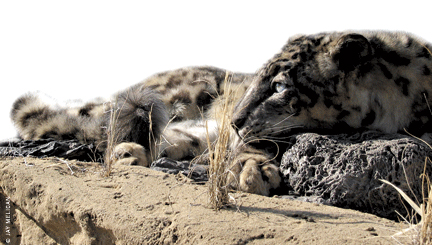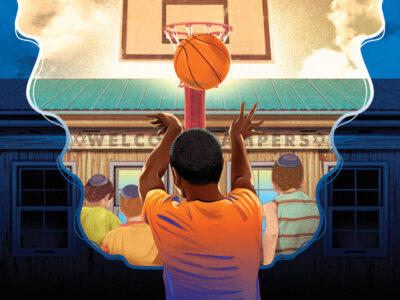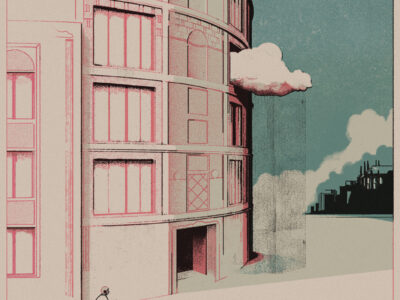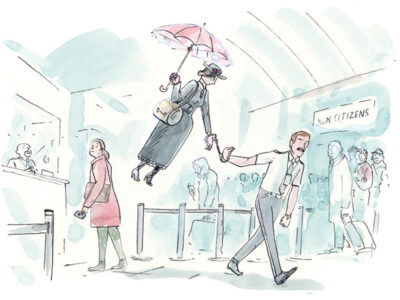
If you’ve always wondered what stuffed animals are all about, there’s no better place to be a fly on the wall than the World Taxidermy Championships.
By Melissa Milgrom
Having driven 1,400 snow-slick miles from Cody, Wyoming, Ray Hatfield was now in the lobby of the Crowne Plaza in Springfield, Illinois, pushing a brass luggage cart with a snow leopard perched on it. He pushed it onto the elevator, rode up to the ninth floor, and then rolled it down the hall to room 918, where he placed the leopard on one of the double beds, its spots curiously blending in with the oak-leaf pattern of the bedspread. Hatfield walked slow circles around the leopard, inspecting it for imperfections. In his hand was a shiny silver blow dryer.
Hatfield runs Nature’s Design Taxidermy, a big commercial studio, which serves mostly hunters. He is tall and soft-spoken, with tawny hair and aviator eyeglasses that adapt to the sunlight. On the drive to Springfield, a few mounts, including the snow leopard, got wet when melting snow leaked into his cargo trailer. Under normal circumstances, damp capes (“cape” is the term used for the animal’s pelt, or skin), if quickly caught, are an easy problem to fix. On this day, however, Hatfield couldn’t risk even a minor flaw. “I’m trying to get all of its hairs separated down to the skin and make all of the hair patterns lie in place,” he said, clutching a wire brush that rapidly filled with soft golden fur. “Everything has to be just right for the competition.”
Hatfield was hopeful of winning a ribbon with the leopard, but his expectations were not high. In this he was realistic. Three hundred fifty taxidermists from 22 countries were competing for 12 Best in World titles and $25,600 in cash prizes. For the next five days, Springfield would be what Atlantic City was to beauty queens and Indianapolis is to racecar drivers: the most extraordinary gathering of competitors in the field.
But Hatfield wasn’t there only to win medals. No one was, actually. That was just the pretext. Taxidermy competitions have long been the single most important place—outside of natural history museums—where taxidermists can highlight their artistry. Indeed, the American taxidermy competitions of the early 1880s gave rise to a new movement in artistic taxidermy. The winners went off to work at the leading museums, transforming their halls from dreary morgues of systematic classification into galleries of simulated nature. Elevating taxidermy’s status was a goal in Springfield as well. Hatfield, for one, was slated to lead a two-day seminar in which he’d demonstrate how one expertly preserves a leopard. Equally important, the World Taxidermy Championships (WTC) offered him a rare opportunity to talk shop with world-class taxidermists from places such as the Milwaukee Public Museum, the Natural History Museum of Los Angeles County, the Smithsonian Institution, and museums throughout Europe.
The lobby of the Crowne Plaza was a veritable Noah’s ark on luggage cars. A taxidermist from Nebraska carted a prairie chicken and a mink; a competitor from Pittsburgh had a black squirrel and a freeze-dried snowshoe hare. Green sandpipers, cougars, geckos, a Bengal tiger, brant geese, chum salmon, marmots, rattlesnakes, and snapping turtles were all being wheeled this way and that in the eccentric migration. The bellhops stood by and watched. They had nothing to do, really, because only a slacker would hand over a mount that he had been preserving for a year or more to the untrained hotel staff.
Cradling a red-tailed hawk in his arms was a taxidermist from Indiana, who paused to say that his raptor wasn’t a raptor at all. It was a fake. “It’s a re-creation made out of turkey, chicken, and goose feathers,” he explained, as if it were perfectly normal to turn chickens into hawks. He was entering it into the show’s most fascinating category: Re-creations. According to the rule book, “Re-creations are defined as renderings which include no natural parts of the animal portrayed ≥… For instance, a re-creation eagle could be constructed using turkey feathers, or a cow hide could be used to simulate African game.” Imitation or not, this hawk looked ready to stalk prey in Lake Springfield’s wetlands. Here, in this convention hotel set amid chain restaurants and highways, a dead circus was coming to life.
The participants, many of whom were from blue-collar families or had grown up on farms, considered themselves outdoorsmen and hunters, and they reflected a distinctly American approach to taxidermy, one linked to hunting in the spirit of Daniel Boone and Davy Crockett. Lured by the infinite bounty of the unexplored wilderness, early white hunters such as Boone and Crockett considered the American West a sportsman’s paradise (a sportsman being someone who hunts for pleasure, not profit). In the early days of the republic, big trophies, such as those displayed by Thomas Jefferson at Monticello, were bought to disprove the European claim put forth by the French naturalist Comte Georges de Buffon and others that animals shrank and became muted in the New World and men lost their virility. Once that theory was debunked, a sizable moose head (or a record marlin) became more personalized. Rich sportsmen from Europe and the United States wanted their kills and catches preserved to commemorate their prowess as marksmen and adventurers. Soon the American West was dotted with taxidermy firms such as Jonas Brothers in Denver, whose trophies glamorized the thrill of the hunt and who also did amazing museum mounts. Today the big commercial firm Animal Artistry in Reno, Nevada, which has prepared mounts for the likes of General Norman Schwarzkopf and country music singer Hank Williams Jr., maintains that tradition.
As Hatfield and I made our way through the parking lot to his cargo trailer, we passed two truckloads of driftwood being sold for bases. All around us, drivers were carrying odd-shaped bundles. Talons, claws, and webbed feet poked out of blankets and garbage bags that had been cut and taped to accommodate the peculiar forms.
Hatfield swung open the trailer doors and stepped inside. Leaning against the walls like furniture in a U-Haul was a herd of Western origin: a buffalo, two six-point elk, and a large mule deer—deliveries for the way home. “Those are elk legs that go to another guy,” he said, pointing to a pair of detached limbs. “It’ll be a lamp.” In the middle of the truck was an enormous mass covered by a blanket. Ray heaved off the blanket, and there sat his monstrous Barbary lion; a mature male with yellow eyes, a grandiose mane that extended down over its belly, and an upright tail exposing a painstakingly crafted hairy scrotum. The species no longer exists in the wild. An Ohio zookeeper had sold the lion to Hatfield for $8,000 after it had died of natural causes. “I’ve done about 80 lions, and this is by far the largest,” he said with the same nonchalance he had displayed while blow-drying the snow leopard. After the show, the lion was going to the collector who had bought it for $20,700. He paused, considering how to haul this king of beasts to the hotel ballroom where the competition was being held. Even without its artificial sandstone outcrop, the lion was far too big to wheel in on a luggage rack.
Outside the ballroom, a 62-year-old cattle-brand inspector from Texas considered his mount: a longhorn calf eyeball-to-eyeball with a writhing rattlesnake, barbed wire, and a sign that said I’M WARNING YOU. “I was just going to have his mouth open saying ‘I’m gonna get you,’ but I didn’t think it was appropriate with a little calf like this.” A woman from Ontario, Canada, gave her two mating bighorn sheep the once-over. “He’s romancing her, to say it politely,” she said, smiling with satisfaction.
When Ken Walker and John Matthews, two taxidermists from the Smithsonian’s National Museum of Natural History, walked in, everyone set down the feather dusters and penlights and looked up, dumbstruck. The Smithsonian taxidermists brought integrity to the show. They brought respect to taxidermy. But that’s not why everyone paused mid-groom. The two men were carrying a life-size giant panda!
“I’ve shot bigger pandas than this!” someone joked from the crowd. It was Dan Bantley walking over for a closer look. Only about 1,600 giant pandas still exist. Killing one for any reason is almost treasonous (the punishment for poaching a panda in China is 10 years in prison), but that doesn’t deter everyone. Black-market panda skins can fetch $100,000 to $300,000 apiece. For all these reasons, everyone gazed at the animal until they realized that this panda wasn’t a panda. It was another entry in the Re-creations category.
That was obvious because the person who had created the panda was the two-time world champion, Ken Roy Walker. If you had to choose a taxidermist who epitomizes the spirit of the WTC, it would be Walker. Although he’s a fierce competitor, his unapologetic love of taxidermy, his good-natured spirit, and his ability to inspire others make him a celebrity in the field. Not to mention his uncanny gift for sculpture.
In the 1980s, Walker owned a bear-hunting outfit called Svartbjørn (Black Bear), guiding mostly Norwegian hunters through Alberta’s vast subalpine forests. He moonlighted as a Roy Orbison impersonator. “I can really sound like him,” Walker said, staring into my eyes and nodding.
At the time, Walker was three months into a nine-month contract at the Smithsonian, which was erecting a new mammal hall and had to hire independent taxidermists because it had closed its taxidermy workshop in the late 1960s. Before he’d left for the museum, however, Walker, who had never seen a real giant panda, had begun to make a fake one. Not a run-of-the-mill forgery, but a panda so convincingly real that you could almost hear its heart beat.
The first step had been finding suitable skins. “I was a bear-hunting guide, an outfitter, for ten years, so I have plenty of hides in the freezer, but I didn’t have the right brown ones,” he said, explaining that he needed two black bear skins for the job. Black bears can range in color from blond to brown to black. Ken needed two brown-colored bears in their blond phase. That means that the fur appears brown but is actually blond at the roots. “I needed the bear to be shot on September tenth, so its hair wouldn’t be too long,” he explained. “If you tell people that, you can usually get one in a week,” he added in the same dispassionate tone you’d use to order a mobile phone.
When Walker arrived at the Smithsonian, he had access to an unbelievable reference: the frozen carcass of Hsing-Hsing, one of the two pandas Mao Zedong gave President Richard Nixon on his historic visit to China in 1972. (Nixon gave China a pair of muskoxen in return.) Hsing-Hsing had died at the National Zoo in 1999, and the museum had acquired his carcass, storing it in three parts: the carcass, the cape, and the head. “They’re afraid to mount it,” Walker said, shaking his head with frustration. The museum saw stuffing the panda as a potential political fiasco. Nixon’s panda had become a powerful symbol of East-West detente, and no one wanted to offend the Chinese. Somehow, in spite of this, Walker got permission to make a template of it. “You think of the odds,” he mused.
Much like a forensic scientist outlining a murder victim on a sidewalk, Walker traced Hsing-Hsing’s carcass onto paper and used the template to make his own panda’s inert body. He bleached the blond bear’s cape white using Clairol hair dye, then he cut and sewed it and another cape together. Using a brown bear face as a model, he cast its lips, teeth, ears, and tongue. He reshaped bear claws to use as panda claws, inserting an extra one into each paw to serve as the panda’s sixth “false” digit. ‘‘Being a visionary taxidermist, I knew what it was going to look like,” Walker said with the elan of a champ. “But I had never seen a panda before, and there I was holding one!”
Now, at the competition, Smithsonian lead taxidermist John Matthews (Walker’s boss) described “Thing-Thing” to the crowd: “That’s a reproduction. Ken made that out of two different brown bears, and he put them together. Now he’s going to put a whole mess of bamboo trees on the base.” Like reporters covering the spectacle this would have been had Thing-Thing been Hsing-Hsing, the taxidermists fired questions at Walker.
“Is it a male or a female?”
“You cannot tell the sex of a panda unless you perform surgery. It’s more or less generic,” Walker said, boring holes into the platform and planting bamboo.
“I got knocked once for not having nipples on a black-squirrel mount that was peeping into a hollow log,” noted Randall Waites as Walker cemented bamboo stalks onto the base, bending one near the panda’s mouth so it appeared to be playfully munching. “Which way’s the sun shining?” Waites asked as a follow-up, eyeing the bamboo to see if it was bent in the proper direction—that is, oriented properly given the sun’s supposed alignment.
Under his grandiose handlebar mustache. Matthews broke into a huge smile. “This is the Super Bowl of taxidermy right here!” he said.
Melissa Milgrom G’92’s fascination with taxidermy began during a safari in Tanzania, when she walked into a “carcass room” filled with a Belgian hunting party’s trophies-to-be. Her curiousity culminated in an attempt to stuff an eastern gray squirrel as an apprentice at Schwendeman’s Taxidermy Studio in Milltown, New Jersey. She lives in Brooklyn, New York. This essay is adapted from Still Life: Adventures in Taxidermy, which will be published in March by Houghton Mifflin Harcourt.




